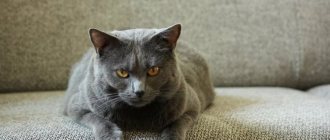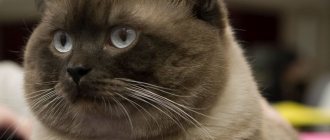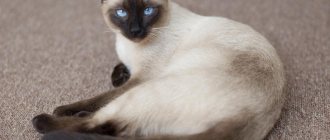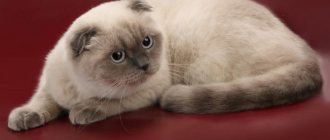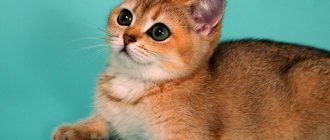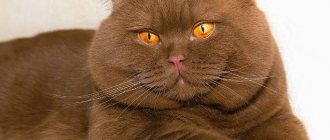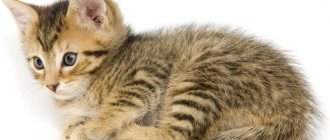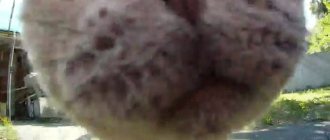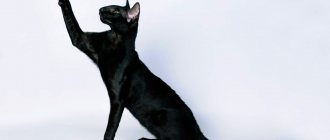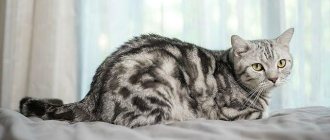British among cats
This breed is popular due to its independent and patient disposition, because British women will never get bored in the absence of their owner. At the same time, plush purrs are not devoid of a sense of tact and show full love to those who take care of them and treat them with tasty treats.
British cats are the embodiment of calm and intelligence
The British are distinguished by high intelligence - by changing the “notes” in the breadwinner’s voice, the cat will understand that it is doing something wrong. However, these little cats cannot be called too mischievous or vindictive - calmness is their strong point. At the same time, British cats are not inclined to become toys in children's hands; with excessive attention from children, the cat will prefer to run away.
Externally, British catfish differ in the following parameters:
- thick coat with dense undercoat;
- round, close-set eyes of amber color;
- massive head on a short neck;
- wide cheekbones;
- small nose with a wide bridge;
- ears widened at the base with rounded tips;
- muscular body on wide, strong legs;
- medium-length tail, rounded at the end.
How the color of the Briton was formed
There are several versions of the origin of the breed - one says that the ancient Romans brought cats from the Egyptian desert in the 1st-2nd centuries. ad. According to another legend, British cats originate from the purring Chartreuse breed, taken by medieval crusaders from the shores of South Africa.
Chartreuse cats are considered possible ancestors of the British breed
The first true Britons who settled Foggy Albion had gray-blue “stuffed” fur. This is how they were depicted in religious treatises (for example, in the Lindisfarne Gospel), poems and bestiaries. Zoologists began selection, which fixed the color, only in the 19th century, at which time the first breed standard was drawn up.
Color is the color scheme and patterns on a cat's fur coat that are formed as a result of the interaction of genetic materials responsible for the production of melanin in the body. The desired shade of coat is obtained by crossing animals with dominant and recessive genes responsible for the pattern and depth of tone. So, in British dogs with blue hair, the set of genes looks like BBdd (where B is the dominant gene that forms the black color, and d is the recessive gene responsible for muted, diluted shades). Marbled cats carry the Tb gene (where T is the dominant tabby color gene, and b is a recessive gene that makes the coat brownish, not black).
Felinologists became concerned with professionally establishing breed characteristics (including color) in British cats only after the Second World War, when the question arose of preserving this variety of domestic purrs:
- 1950 - official recognition of the British Blue breed;
- 1967 - British blue cats received the champion title from the ACA association;
- 1977 - ban on mating with other breeds, including Chartreuse;
- 1980 - recognition of the breed by the CFA Association.
Where does the British marbled cat come from?
Since the beginning of the 20th century. British cats included not only plain blue animals, but also tabby cats with different shades on their fur coats. Thus, in 1901, American felinologists registered a Belle cat with a red tabby color.
British marbled cats appeared as a result of crossing with other breeds
The consequence of two world wars was the almost complete extermination of the British breed, so breeders began to crossbreed pets with representatives of other varieties - Burmese, Russian Blues, Persians and Scottish. The result was the appearance of many varieties of British color while simultaneously preserving the breed characteristics (wide paws, protruding cheekbones, “plush” coat).
At the same time, among all the variations of the striped coat of the British fur coat, it is the marble color that is considered classic, occurring naturally. Zoologists are inclined to believe that the symmetrical darkening on the fur of catfish from Foggy Albion is an inheritance from wild Asian or African ancestors.
Life in the wild
Modern scientific observations of a rare species of felines are taking shape literally bit by bit. A lot of valuable data was obtained when a special chip was implanted in a wild-caught marbled cat in 2000. Episodic information is also obtained from video cameras that are installed in many reserves and record the life of the animals living there.
Rare footage from a surveillance camera
Where does the marbled cat live?
The favorite habitats of Pardofelis marmorata are impenetrable tropical forests, away from human paths and dwellings. But some small populations willingly settle in high mountainous rocky areas, where any vegetation is practically absent. The territory that one animal “superses” is about six square kilometers.
The marbled cat spends most of its life in trees
Lifestyle and character
Marbled cats are unsurpassed steeplejacks; they move much less often on the ground than on the branches of tall trees, flying up their trunks with lightning speed at the first need. Here, in the tree crowns, under the cover of dense foliage, a significant part of the marbled cat’s life takes place. She leads an exclusively nocturnal lifestyle, and during daylight hours she sleeps, sitting comfortably on the branches.
She kind of looks like a squirrel, doesn't she?
Hunting is the main essence of the marbled cat; both its strong body and its entire way of existence are ideally suited for this activity. This ideal huntress can lie motionless for hours, like a statue, waiting for her prey to appear. But as soon as the right moment comes, the predator makes a killer throw - lightning fast and accurate; Almost all of her attacks are effective.
The marbled cat is also excellent at tracking down prey - here its excellent sense of smell and acute vision become its faithful assistants: the animal sees well in the dark.
Video: marbled cat walks through the forest
Nutrition
The diet of the marbled cat is very varied, and it supplements its menu by mainly hunting in the crowns of trees. Here, tree squirrels, bats, and, of course, various birds can become predator trophies. On occasion, she will not refuse to feast on other small prey: rodents, amphibians, reptiles and even large insects, which are found in abundance in the tropics.
The marbled cat hunts not only in the crowns of trees, but also in reed thickets
These cats have a good appetite - the daily diet of the predator reaches up to 0.8 kilograms in weight, which is approximately a sixth of the live weight of an adult animal.
Reproduction
These animals spend most of their lives alone: controlling the borders of their territory and protecting them from the invasion of strangers. But once a year, a marble cat and a female cat meet to indulge in the joys of love. And in this most important intimate matter, they also differ from most of their relatives. This species does not have a mating season determined by the time of year - a couple is formed when a mutual desire arises.
The season of love for marbled cats occurs at any time of the year.
In preparation for giving birth, the expectant mother cat begins to arrange a den in advance in which she will raise her offspring. The most inaccessible place for the nest is selected: in the hollow of an old tree or a cave hidden in dense grass thickets.
Pregnancy in a female lasts slightly longer than in other representatives of the cat family - up to 85 days. At the time prescribed by nature, blind, deaf and helpless kittens will be born - there are rarely more than four of them in a litter, and at first they look completely unmarbled. At birth, babies weigh no more than one hundred grams. And the first fur of newborn cubs has a uniform brownish tint; beautiful dark stains will appear on it much later, by four months.
By four months, the kitten's baby fur has completely changed to that of an adult.
Main threats
The main risks for the existence of the marbled cat are human economic activity - deforestation and the development of the ancestral territories of the wild species.
The marbled cat's natural enemies are larger predators, mainly its fellow cats living in the same region. The wild Bengal cat, whose habitats often overlap in the marble cat, could compete in terms of food supply. But the first of the small predators hunts only on the ground, and the second - mainly on the upper tier of the tropical forest.
The masterly ability to climb trees helps not only to hunt, but also to escape from other predators.
Types of merle colors among the British
This color belongs to a group of colors called tabby (from the name of the striped fabric brought to England from Baghdad). The peculiarity of this pattern is the continuity of lines and the uniqueness of the pattern for each individual. Thanks to the efforts of felinologists, today the British marble coat is represented by many varieties.
Black marble
The main background of the coat is dark gray, the stripes have a pronounced black tint. There is a black outline around the eyes and nose, the color of the eyes is brown-orange.
British black marble shades are highly prized by animal lovers.
Black marble on silver
Charcoal stripes and spirals are symmetrically arranged on a silver background. There are dark spots near the eyes and the red-brown nose.
Black marble on silver - exquisite colors of British cats
Black marble on gold
The main color of the coat is copper-golden, the stripes have a black or dark brown tint. The eyes are most often green or yellow.
The British with the “black marble on gold” color look very presentable
Lilac marble
The silver fur coat is decorated with patterns of lavender or peach undertones. There is also a lavender rim around the nose and eyes. The iris is yellow or pale brown.
British cats with a lilac-marble hue are quite unusual
Tortoise marble
The main background can be silver-red or silver-brown, while the spots and patterns remain black or dark brown. The eyes are often yellow or greenish. The color is characteristic only of females; in rare cases it is found among males. Cats with this color cannot have offspring due to genetic characteristics.
Tortoiseshell marble involves adding reddish shades to the main color scheme
Chocolate marble
The fur coat is the color of milk chocolate, the pattern is dark brown. The eyes and nose are outlined with thick chocolate eyeliner. The color of the iris is from yellow to golden brown.
Chocolate Marble is a common color option among the British.
Bicolor
The main color with spots is diluted with white inserts on the paws, chest and belly. Eyes can be yellow, brown or green.
Bicolor color is also found among British harlequins.
Red marble
The light red fur of the main background is decorated with spots and streaks of a rich red hue. The eyes are orange, brownish-golden.
Red merle is a red British breed with merle patterns on their coats.
Red marble on silver
It is distinguished by a silvery tone of the main background, the spots have a light red color. The fur around the eyes is white, the nose is pink. The eyes are yellow or golden.
Red marble on silver - a spectacular coat color for the British
Cream marble
The main background has a shade of creme brulee, and the spots tend to be peach. There are white hairs around the eyes and a pink nose. Eyes yellow or gold.
Cream marble is a very delicate shade of the fur of British cats.
Blue marble
Silver coat with smoky gray stripes and spots, dark gray lining around the nose. The eyes are not circled and have a brown-golden tint.
The British in the shade of “blue marble” look noble
Spotted and striped colors (tabby)
All varieties of the “wild” British tabby color are characterized by an “M” on the forehead, “necklaces” on the chest, and dark stripes on the muzzle. The colors are presented here in subgroups:
- Striped. This color is called tiger, sprat or mackerel (mackerel). This is the most common tabby color of the British breed. As the name implies, the color of the cat resembles that of mackerel, sprat or tiger. There is a dark stripe along the ridge and part of the tail, and on the sides there are stripes that should not turn into spots.
- Spotted. This Briton resembles a small leopard. There is a dotted stripe along the spine, clear and bright spots on the sides, and stripes on the cheeks.
- Marble. On light wool there are dark patterns, curls and circles. A contrasting pattern is valued, the details of which do not intersect with each other.
- Silver tabby. The undercoat is white-silver, on the guard hairs there is a black pattern: spotted, striped, marbled.
- Golden tabby. The undercoat is apricot, on the guard hairs there is a bright red pattern: striped, spotted, marbled.
- Torbiko. A rare color consisting of three colors - white, tortoiseshell and tabby. On a snow-white background there will be individual spots of color with a spotted-striped pattern.
- Thorby. The cat's coat is tortoiseshell: black-red, chocolate-red, cinnamon-red, fawn-cream, blue-cream, lilac-cream. A striped pattern is visible under this color.
Marble Tabby:
“Wild” tabby color:
Silver Tabby:
British tabby color:
Marble color standards
In addition to the basic standards of the breed, additional requirements have been established for British merles, which must be present in the exterior. The absence of at least one sign leads to the culling of the pet and the inability to participate in further breeding.
Marble British should have a clear pattern
Interestingly, the classic letter “M” on the forehead of tabby cats is associated with the prophet Mohammed. Allegedly, when the saint picked up a marble cat, the hair on its head became colored in a specific way. Which became a sign of the Higher Powers’ love for these purrs.
So, the marbled British cat is distinguished by the following characteristics:
- brightness, symmetry and clarity of the pattern on the fur coat;
- absence of intersections and broken lines in the patterns;
- the hairs are colored in two ways (in several shades - the hairs of the main background, in one color - the hairs of the patterns);
- the color of the iris depends on the shade of the coat; it can be copper, hazel, greenish or brown;
- there are “necklaces” on the chest, and two dark curls running parallel on the cheekbones;
- the forehead is marked with a pattern in the shape of the letter “M”, on the back of the head and shoulders there is a pattern in the form of a butterfly;
- the outer side of the ear closer to the base has a white spot;
- three long stripes of distinct dark color stretch along the ridge;
- the hips are marked with circular closed patterns;
- the tip of the tail is always marked in a dark color;
- There is a bright outline around the eyes and nose.
In addition, a classic marble cat should have small, far-set ears and massive paws. At the same time, the color of the skin on the pads of the paws, as well as on the nose, depends on the color of the animal’s fur - the darker the fur, the richer the skin tone. Seals with a silver background have pink paws and noses, red ones have crimson purrs, and “dark” British cats are completely brownish.
Table: EMS codes for coat colors in cats
| Code number | Transcript (in Russian) | Transcript (in English) |
| Main color | ||
| a | blue (blue) | blue |
| b | chocolate (Havana, brown, champagne, chocolate) | chocolate (brown, chestnut) |
| c | lilac (platinum, lilac, lilac) | lilac (lavender) |
| d | red (ed) | red (flame) |
| e | creamy | cream |
| f | black tortoiseshell (sil-torti, tortoiseshell) | tortoiseshell |
| g | blue tortoiseshell (blue-cream tortoiseshell, blue cake) | blue-tortie (blue-cream) |
| h | chocolate turtle (chocolate cake) | chocolate-tortie |
| j | lilac tortoiseshell (lilac-cream tortoiseshell, lilac-torty) | lilac-tortie |
| m | caramel | caramel |
| n | black (ebony, sable, wild, seal) | black (ebony, sable, ruddy, seal) |
| o | cinnamon (sorrel, honey) | cinnamon (sorrel, honey) |
| p | faun (beige, fawn) | fawn (beige) |
| q | Tortoiseshell cinnamon (cinnamon cake) | cinnamon-tortie (sorrel-tortie) |
| r | tortoiseshell fawn (fawn-tortie) | fawn-tortie |
| s | silver | silver |
| t | amber (amber) | amber |
| w | white | white |
| y | gold | golden |
| x | unregistered color | unregested |
| Degree of white spotting | ||
| 01 | van | van |
| 02 | harlequin | harlequin |
| 03 | bicolor | bicolour |
| 04 | bicolor for color points | mitted\white point |
| 05 | snowshoe | snowshoe |
| 09 | small white spots | little white spots |
| Tipping degree | ||
| 11 | shaded (shaded, shedded) | shaded |
| 12 | chinchilla (veil, veiled, tipped, shell) | tipped (shell) |
| Type of drawing | ||
| 21 | tabby, agouti | tabby (agouti) |
| 22 | marble (marble) | blotched (marble, classic) |
| 23 | tiger (mackerel) | tiger (maskerel) |
| 24 | spotted (rosette) | spotted |
| 25 | ticked | ticked |
| Acromelanic colors | ||
| 31 | Burmese (sepia) | burmese (sepia) |
| 32 | Tonkinese (mink, mink) | tonkinese (mink) |
| 33 | Siamese (Himalayan) | siam (himalayan) |
| 34 | Singaporean | Singapore |
| Tail length | ||
| 51 | rampy | rumpy |
| 52 | ramp riser | rumpy riser |
| 53 | stumpy | stumpy |
| 54 | longs | longy |
| Eye color | ||
| 61 | blue | blue |
| 62 | yellow | yellow, golden |
| 63 | disagreement | oddeyed |
| 64 | green | green |
| 65 | Burmese color | burmese color |
| 66 | tonkinese color | tonkinese color |
| 67 | siamese color | siam (himalayan) color |
| Ear shape | ||
| 71 | straight | straight |
| 72 | curl | curled |
| 73 | fold | fold |
| Coat type | ||
| 81 | long wool | longhair |
| 82 | short hair | shorthair |
| 83 | brush | brush |
| 84 | straight | stright |
Classic colors
The breed standard includes 229 color and pattern options. Each of them must meet the requirements for the cat to be called a pedigree cat. Before a kitten receives documents and moves to its owner, a specialist checks it for compliance with the standard. They also examine the color, which is characterized by colors:
- undercoat;
- awn;
- drawing, if present;
- eyes, nose and paw pads.
These indicators are influenced by genetics - the coat colors of parents and distant ancestors. Some of them are dominant, others are recessive. When selecting pairs for mating, color compatibility is taken into account. The classic ones include solid, or solid, solid hair along the entire length of the hair. More details about the professional color coding of British dogs can be found in the table below.
Blue
When people picture a British Shorthair, the image that comes to mind is the classic British Blue cat or kitten with dense bluish fur and amber eyes. This coloring is the epitome of the British Shorthair.
The blue or gray color is the first officially recognized in the breed. It appeared because at the stage of creating the British Shorthair, the blood of Russian Blues was infused. This is an extremely attractive coloration.
To be a true British Blue, a cat must have a coat color ranging from light blue to blue-gray, with no hint of striping or white hair. Babies often have light silver markings, but over time the color evens out. The skin on the nose and paw pads is also dark gray, matching the cat's fur. Cat eyes are bright orange or deep amber in color. Many kittens have brown eyes, which acquire the desired shade by adulthood.
White
Pure white color is recognized - and this is the only case where snowy hairs are allowed on the Briton. To be a show level cat, the white tone must be pure, without any yellowish tint.
Sapphire blue or orange eyes with copper, amber or gold tints are allowed. Britons can have one sapphire blue eye and one amber or gold eye; other combinations are not permitted. The skin is pink.
Black
Black cats have fur that is pure black, without rusty hues or brown spots. A shade of rust is unacceptable; the fur must be charcoal.
In summer, such animals can burn out in the sun if they have access to the street. Black leather on the nose and paw pads (no markings) complements this coloration. The breed's classic orange eye color creates a striking combination with black fur.
Chocolate
British Shorthairs got their chocolate color from crossing with Persians. There is a lot of work behind this to curb the tendency for hair to become longer and restore proper coat texture.
It's a beautiful color, especially when paired with orange eyes. The shade can vary from rich chocolate to dark chocolate.
Lilac
The term “lilac” or “lilac” is used by felinologists to denote a delicate frosty gray, which is lighter than classic blue and has a noticeable pinkish tint. The nose skin and paw pads of the Lilac British Shorthair should be colored like fur.
Red
It assumes a rich red coat color, with as few stripes and markings as possible. Like ginger-haired humans, these cats sometimes have freckles on bare areas such as their pads, nose skin, ears, eyelids and lips. While there are only a few freckles, judges at shows do not fine even adult cats for them.
Cinnamon
Cinnamon - the color of cinnamon - was included in the breed standard recently. Cats with this coloration have a warm reddish-brown color, similar to the spice of the same name. They may have pink or cinnamon noses and paw pads.
Faun
The word "fawn" is used to refer to fawn cats whose fur is a light and warm shade of pink. Their nose skin and paw pads must be yellowish-pink to meet the breed standard. The most common defect is silver spots, which are only acceptable in kittens.
Cream
Cream, or peach, is a color similar to cream: pale white or beige. The skin of your cat's nose and paw pads should be pink.
Cream cats may have several stripes, but they should be as faint as possible. Like red cats, cream cats sometimes have freckles.
Anomalies and features of merle color in the British
A plush fur coat with streaks and patterns reminiscent of a cut on marble is considered one of the most difficult in terms of proximity to standards. If you plan to purchase such a kitten, breeders and experienced owners recommend taking a baby no younger than 4–6 months of age. By this time, the pattern on the coat will be completely formed and the slightest deviations from the norm will be noticeable.
British merles have the same developmental anomalies as other cats.
At the same time, British harlequins have clearly marked stripes and circles on their coats from birth. If the degree of coloration of the hairs in the pattern is excessive, then the final pattern will be blurry. Then they talk about “false marble”, or moire, among the British. This is an anomaly due to which the animal is not allowed to be bred.
Disadvantages that reduce points at exhibitions:
- torn edge of the pattern;
- The picture is too large and overlaps the main background.
Anomalies leading to a ban on procreation:
- polydactyly;
- too many rings around the eyes;
- kinks on the tail;
- disorders in the structure of the jaw.
Caring for the British Marbled's fur coat
The breed is one of the cleanest and neatest cats, so the animal often takes care of its appearance on its own. At the same time, it is recommended to wash the cat every six months and comb its elegant fur at least once a week.
British marble cats do not require special care
Since the coat of British cats is quite elastic and flexible, there are no special rules for caring for it. It is recommended to regularly clean the animal’s ears (with cotton swabs dipped in warm water) and the animal’s eyes (with warm and damp cotton pads) - every 7-10 days.
Video: British marbled cat
Content
British cats are fairly unpretentious animals that can live in a home for up to 15 years.
To do this, you just need to follow a few simple rules of care. Particular attention should be paid to their thick coat. This animal needs to be brushed once a week.
For this, you can use a special comb with “droplets” on the tips of the teeth so that the animal does not get hurt. But during the molting period, this needs to be done much more often, every two days. In addition, brushing should be taught from childhood; this can be done as early as 2 months, when the furry pet begins to explore everything around.
Such cats love to lick themselves, which is very dangerous during the molting period. After all, the hair will settle in their stomach, which may result in intestinal problems.
From the age of six months you can start bathing your British cat. This must be done as they become dirty. However, for their health, bathing should be done no more than 2 times a year. You can use a special shampoo, which is sold at any veterinary pharmacy. In the most urgent cases - for example, participation in various exhibitions or severe pollution, pets can be bathed more often.
In addition, when you bring home a small kitten, you need to take care of its housing. You can equip him with a small corner: build or buy a special house. You can install it in a place convenient for the owners, but if the pet doesn’t like it there, then you will need to give in. Otherwise, the proud Briton will live wherever he wants.
However, no special effort is required, since cats are clean
When buying a litter tray, you need to pay attention to its dimensions. The tray must be large, since cats themselves are quite large.
It is better if the toilet is closed.
The cat must also like the filler, otherwise he will not go to the toilet. Therefore, when buying British dogs, you should definitely ask the breeders which one they used. If there is no such information, then you need to buy litters that do not get wet, so that the pet does not later spread dirt throughout the house.
It is imperative to take care of your pets' claws. They must either be trimmed regularly or a scratching post installed in the house so that the pet does not damage the wallpaper or expensive furniture.
Black Britons will need annual vaccinations, as well as treatment for various parasites
This is especially important if the pet walks outside. You can buy a special collar for him or use suitable medications
In addition, you must hang a tag on the collar with the address or telephone number of the owners - in case the Briton gets lost.
Be sure to monitor the health of the animal. After all, despite the excellent immune system that they inherited from their ancestors, the British are susceptible to disease. These may be heart diseases, for example, hypertrophic cardiomyopathy, which is incurable. But it is still possible to prevent it. To do this, you need to give your pet an ultrasound once a year. It will be better if the same doctor begins to monitor the cat.
Black Britons are susceptible to dental disease, so they need to be looked after with particular diligence. That is, buy special toothpastes and brush your teeth regularly, as well as remove tartar on time. After all, if this is not done, then they can lose up to 30 percent of all teeth.
Knitting features
The British merle color is one of the most difficult to breed due to the high degree of moire among the offspring. Felinologists still cannot track the pattern of appearance of vague patterns. The most common reason is the crossing of a merle parent with a solid-colored Briton.
British marbled cats can only be knitted with each other
Everything is explained by the genetics of color - the gene responsible for the merle pattern is recessive, and the gene for uniform color easily overlaps it. Therefore, in order to preserve breed characteristics, it is important to breed only between British Marbleds. In exceptional cases, crossing with representatives of the breed that have a tiger (mackerel) color is allowed.
Description
Marble chips are a natural mineral, crushed to the state of flour or crystals, the size of which on average varies from 0.5 to 2 cm. The particle size is determined by the external section. During production, the material goes through the stages of drying, dust removal and sorting. Outwardly it resembles sand, but in origin it is a crushed stone.
The mineral is mainly mined in quarries in the Trans-Urals, Western Siberia, Altai, and Krasnoyarsk Territory. The stone itself is formed by combining rocks under pressure and high temperature. It can have different densities and consists of dolomite, calcite or a combination of both. It may contain suspensions of organic origin, which determine the shade of the mineral.
Marble chips are made from illiquid pieces of marble, as well as its waste. The product that meets the requirements of GOST 22856-89 goes on sale. The size of the granules is directly related to the mass: the larger the crumb, the more it weighs.
To the exhibition with the marble Briton
Since British cats were officially recognized as a breed back in the 1980s, these purrs regularly participate in advertising shows, seminars and exhibitions. Marble Britons were no exception.
British marbled cats are regulars at exhibitions and shows
Before sending your pet to a competition, it is necessary to carry out hygiene procedures - wash the animal, clean the eyes and ears, and comb the hair thoroughly. You also need to carefully trim the tips of the claws and give the fluffy a little sedative before the trip (1-2 drops of valerian).
To participate in the exhibition you must meet a number of requirements:
- have a veterinary passport and a document about the origin of the cat;
- the animal must be completely healthy;
- Murka should not have fleas and other parasites;
- The minimum age of a cat is limited to 3 months.
The British Marble will not be allowed to compete if:
- aggressive behavior;
- deafness;
- the presence of tattoos and other interventions in appearance.
Breeding
Puberty in British cats occurs at the age of 10 months. The pet's increased excitability indicates its readiness to reproduce: the animal often screams, begins to scratch furniture, and may bite. During this period, the owner is faced with a difficult choice: to sterilize the pet or give him the opportunity to continue his family. In some cases, sedatives in the form of drops help. Sedatives can be given to a 1-year-old pet 7-14 days before mating season.
The first copulation should take place no earlier than the pet turns 1.5 years old. Until this time, the cat’s body continues to develop. Mating before reaching 1.5 years of age can lead to difficult pregnancy and childbirth in females, the birth of weak kittens, and in males to erectile dysfunction.
Mating is carried out on average for 2-3 years of a pet’s life:
- the cat must be brought to the territory of a domestic cat and given time to adapt to new conditions within 3-4 days;
- after getting used to it, the cat will let the cat come to her and give him the opportunity to sniff her;
- It is more effective to arrange mating 2-3 days after the start of estrus.
The pet's potential partner must be vaccinated and healthy. It is not recommended to allow cats near young cats, as they can harm them.
It is important to remember that unneutered cats actively mark their territory. Because of this feature, the apartment begins to smell unpleasantly of urine.
